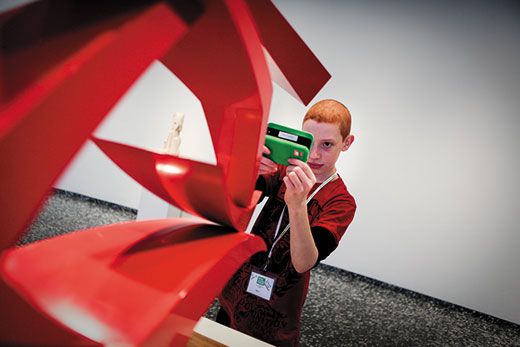Collaborations
/https://tf-cmsv2-smithsonianmag-media.s3.amazonaws.com/filer/FromtheCastle-scavenger-hunts-teens-hirshhorn-631.jpg)
Imagine a time when students in one of the poorest schools in Africa become scientists for a week by measuring the health of nearby forests and comparing their results with data collected by students and scientists around the world. Or when K-12 students at U.S. military bases in remote locations access the collections of the Smithsonian American Art Museum and learn about them from the museum‘s art educators. Actually, that day is here. Such programs are the vanguard of the Institution‘s approach to learning, which focuses on what Claudine Brown, our new assistant secretary for education and access, calls “action-based learning.” In tune with the popularity of digital devices, this form of learning builds on curiosity while emphasizing fundamentals, teamwork and communication.
Our partners in this work include the Bill & Melinda Gates Foundation, which recently provided $30 million to create the Youth Access Endowment; it will enable us to connect to a generation of Americans who might not be familiar with the Smithsonian, or who cannot afford to visit our museums in person. The U.S. Department of Education awarded $25.5 million to our National Science Resources Center (supplemented by more than $8 million raised by the center from private donors). This will further enrich our 20-plus years of implementing a comprehensive approach to transforming K-12 science education programs in more than 1,200 school districts in 48 states representing 30 percent of the U.S. student population (see nsrconline.org). In April 2010 the Pearson Foundation committed $2.2 million to support the use of mobile learning approaches. For example, last summer the National Postal Museum and the Hirshhorn Museum and Sculpture Garden held 21 workshops for teachers and students. Participating teens learned how to curate their own exhibitions and produce videos and podcasts as they created theme-based scavenger hunts using mobile learning devices.
The Smithsonian has also joined Microsoft Partners in Learning and TakingITGlobal to create a program called Shout. It offers educators and students worldwide the ability to interact with each other and their communities, and online with top scientists and other experts to learn about and take action on environmental issues. One example of Shout is the forest-health measuring described above.
Another leading-edge digital collaboration is the Google Art Project, which lets online visitors stroll through the halls of the Freer Gallery of Art—using Google Street View technology—and examine artworks in brushstroke detail through gigapixel imaging.
For more information about the Institution‘s digital programs, visit smithsonianeducation.org. We invite you to join us in imagining a future where education is available to the world at the touch of a digital tablet—a future that excites new generations about learning and helping to solve global problems.
G. Wayne Clough is Secretary of the Smithsonian Institution.
/https://tf-cmsv2-smithsonianmag-media.s3.amazonaws.com/accounts/headshot/wayne-clough-240.png)

/https://tf-cmsv2-smithsonianmag-media.s3.amazonaws.com/accounts/headshot/wayne-clough-240.png)